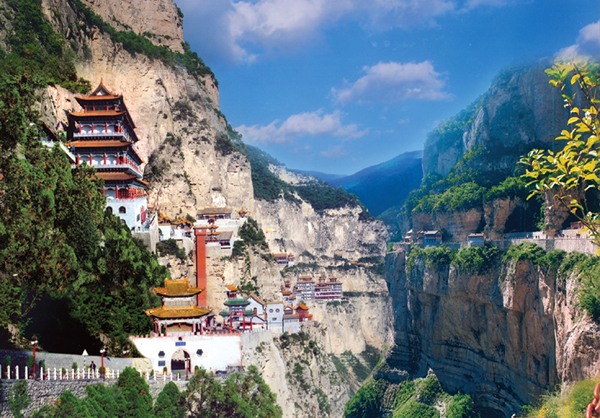Mianshan Mountain

I Overview
Mianshan Mountain is the birthplace of national intangible cultural heritage -- the Chinese Qingming/Hanshi Festival. It is located in Jiexiu City of central Shanxi Province, 137 kilometers south of Taiyuan and 125 kilometers north of Linfen.
The mountain is noted for its natural and cultural scenes, especially for its cultural relics. Visitors can take a five- to seven-day trip to learn about Cold Food culture, Buddhist culture, Taoist culture, military culture or health preservation culture.
Covering an area of 75 square kilometers, the mountain is a national scenic spot with 14 tourist areas and 400 attractions.
The spectacular scenes at Mianshan provide tourists with many choices:
• Climbing Dragon Ridge Peak
• Worshiping Jie Zitui, a well-known loyal official from ancient China
• Traveling to the holy caves
• Watching the sun set at Dragon Head Temple
• Visiting Daluo Palace, the largest Taoist temple in China
• Walking along the Sky Bridge
• Visiting Funnel Spring Palace
• Climbing the steps in front of Zhujia’ao Temple
• Watching the bell at the Buddhist Yunfeng Temple
• Exploring the winding Qixian Valley
• Hiking to Lord Jie Ridge
• Experiencing the natural beauty in Shuitao Valley.
Mianshan Mountain is worth visiting in any season. Visitors are able to participate in local traditional activities and watch folk performances.
There are seven upscale restaurants and six starred hotels built hanging on the cliff. Many railways and highways lead to the mountain. Guides, cable cars and elevators are also available.
II Cultures
The mountain was also named Jieshan Mountain after Jie Zitui whose story can be traced back to the Spring and Autumn Period, some 2,500 years ago. At that time, the state of Jin was in turmoil and one of the princes, Chong'er, was exiled. Jie Zitui, one of his faithful followers, saved the prince by slicing some flesh off his own leg and cooking a dish for him when he was on the verge of starvation.
Nineteen years later, the prince was restored to the throne as king of Jin. His followers were awarded and honored, but he forgot his savior. Jie asked no rewards and retreated to Mianshan Mountain to live in seclusion with his mother.
Years later, Chong'er felt so guilty that he went deep into the mountain to look for Jie, but his efforts were in vain. Eventually, the king ordered to set fire on the mountain to force Jie out. Jie and his mother refused to see the king and were later found dead under a willow tree on the mountain.
To convey his grief and to keep Jie Zitui's memory alive, Chong'er called his people to make no fire and eat cold food on the day. Since then Cold Food Day and the customs associated with it have spread.
On the next day of the Cold Food Day in the following year, the king went to worship Jie with his ministers on the mountain. Seeing the burnt willow tree was revived, he remembered what Jie said to him when he cut the flesh off his leg. "I do not ask any reward and only hope you be an honest and upright head of the state," he said. The king renamed the willow tree the "Qingming" tree in memory of Jie Zitui and ordered the day, 106th day after the Winter Solstice, the Qingming Festival, meaning the sky is pure and the earth is bright.
Feng Jicai, chairman of the Chinese Folk Literature and Art Association and vice chairman of China Federation of Literary and Art Circles, said that Mianshan Mountain is the original point where the festival was started. The legend of Mianshan Mountain is exactly matched with history in the time, site and characters of the story, which is rare for Chinese traditional festivals.
III Development
With a history dating back some 2,500 years, Mianshan Mountain boasts enchanting natural scenery and rich cultural significance. Unfortunately, most temples and cultural relics on the mountain were burned down by invading Japanese troops during the war with Japan in the 1930s and 40s. Annually, the mountain was seeing fewer than 10,000 tourists.
In 1995, Yan Jiying, president of Sanjia Coal Group in Shanxi Province, visited the mountain and decided to invest in its rebuilding. The Government of Jiexiu City supports the investment by releasing a series of favorable policies.
After more than 10 years of construction, 14 tourist areas and 400 attractions have been restored with a series of 5-day trips. The rebuilt landscapes, along with convenient transportation and considerable accommodation, have made the scenic spot leading in visitors and ticket proceeds since it opened in 2000. In 2009, the number of visitors to the mountain reached 750,000, and overall revenues soared to 100 million Yuan.
IV Events
With restored cultural sites, a series of cold-food banquets and recreational activities, the culture Qingming Festival is on display and carried forward. The Qingming Festival, also known as Hanshi Day, was included on the first National Intangible Cultural Heritage list in May 2006.
In December 2007, the State Council named the festival a national holiday. In April 2008, the first Qingming/Hanshi Cultural Forum was launched on Mianshan Mountain.
In April 2010, the third forum was held with the theme "Experience Qingming Culture in the Birthplace." With seminars, exhibitions, performances and public memorial ceremonies, the Qingming culture was presented to visitors and its social value was spread and carried down.
 0
0 







Go to Forum >>0 Comments